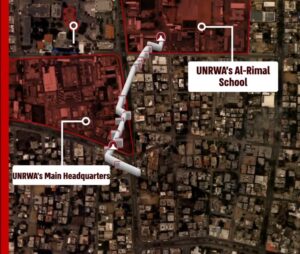Buried 18 meters under a United Nations headquarters in the Gaza Strip is a Hamas tunnel and data center, Israeli army engineers announced on Saturday.
That’s also how deep, in paragraphs, the New York Times buried news of the discovery.
The finding was clearly newsworthy, especially at a time of international scrutiny of UNRWA, the UN body whose headquarters sits above the Hamas center. Only weeks earlier, Israel had revealed that that some UNRWA employees had participated in Hamas’s brutal Oct. 7 attack.
Beyond that, the existence of an important Hamas asset under a UN facility highlights Hamas’s use of civilian infrastructure as shields, and consequently the difficulty in fighting the terror group while minimizing damage in Gaza.
 Other news organizations were clear about the significance of the news. “Hamas military compound found beneath U.N. agency headquarters in Gaza,” a Wall Street Journal headline announced. “Israel says it discovered tunnels under U.N. agency’s Gaza headquarters,” noted NPR’s headline. “Israel unveils tunnels underneath Gaza City headquarters of UN agency for Palestinian refugees,” the Associated Press’s headline read.
Other news organizations were clear about the significance of the news. “Hamas military compound found beneath U.N. agency headquarters in Gaza,” a Wall Street Journal headline announced. “Israel says it discovered tunnels under U.N. agency’s Gaza headquarters,” noted NPR’s headline. “Israel unveils tunnels underneath Gaza City headquarters of UN agency for Palestinian refugees,” the Associated Press’s headline read.
For New York Times headline writers, though, the story of the day was UNRWA’s valor and Israeli whining: “U.N. Agency in Gaza Fought Hamas Infiltration; Not Hard Enough, Israel Says.”
It was in this article that news of Hamas’s compound was buried. Other news, meanwhile, was reported with the clarity of a dark and muddy pit. Consider this turbid language by reporters Patrick Kingsley and Ronen Bergman: “Over the years, several people who had proven Hamas links were fired or left the agency.”
It’s a case-study in imprecision. How many are “several”? Why conflate “fired” and “left,” two different actions with different implications? Were most of the “several” Hamas-linked employees ousted, as the first word indicates, or were they not fired, as the second word suggests? And what were those “links,” exactly? (Readers would have to look elsewhere to learn, for example, that an UNRWA school principal was elected to the Hamas political bureau, the terror group’s small, inner circle of leaders. UNRWA initially denied his affiliation, but later backtracked and suspended him. A senior UNRWA engineer was likewise elected to the political bureau.)
The Times’s assertion that that UNRWA “fired most of the 12 employees accused of connections of Oct. 7” provides further opaque imprecision. Not all were fired? How many? And what about the rest? Were they killed in the attack, or do they continue to work for UNRWA despite their involvement in a massacre? We don’t know, because the Times reports the story as if these questions are irrelevant, both to interested readers and to the questions of UNRWA’s integrity.
“I have never heard about a larger failure regarding any humanitarian aid project.”
Debate with UNRWA in the Foreign Affairs Committee, where I asked several questions but got no answers. My conclusion: we simply cannot give this organisation any more chances.
My speech ⬇️ pic.twitter.com/UfmSO13Fd3
— David Lega (@DavidLega) February 13, 2024
It is one thing to bury news deep in a story or cloak it in opaque language. But nothing conceals better than silence, which is what readers heard in response to UNRWA’s self-serving claims in defense of its impartiality. “UNRWA’s leaders say the agency strives to ensure its 13,000 employees in Gaza uphold standards of neutrality, regularly training its staff to stay above politics and investigating those who do not,” the Times reports. “But they add that it is impossible for UNRWA — like any large organization that draws its staff from a cross-section of society — to track the private political allegiances of all its employees.”
Although an Israeli army spokesman is quoted elsewhere focusing on the tunnel, the voices of those in a position to challenge this claim of neutrality by “UNRWA leaders” are suppressed. Hillel Neuer, who heads an NGO called UN Watch, has documented a longstanding pattern of UNRWA officials and teachers fomenting antisemitism and glorifying terrorism. Employee after UNRWA employee have encouraged stabbing attacks on Israelis; encouraged shooting attacks; encouraged “slaughter”; praised Hitler; spread Holocaust denial; posted images of Hamas leaders as their Facebook profile photo; called for jihad whether by bullet or pen; insisted that Jews in “Jew York” control America; urged that children be taught violence; celebrated the 1929 massacre of Jews; and on and on.
The authors, who quote three current or former UN employees defending UNRWA or contextualizing its connections with Hamas, don’t quote Neuer.
They could have turned instead to Einat Wilf, a longtime and prominent critic of UNRWA, for what she argues is its role as an obstacle to peace. Or Adi Schwartz, another expert on UNRWA. European parliamentarians, analysts from any number of NGOs, and journalists might have offered readers independent, third-party perspectives that differed from those held by the newspaper’s UN-linked sources.
But why let that get in the way of a bad headline?
Former UNWRA chief spokesman, UNESCO coordinator for Mid East Peace Process & BBC journalist @ChrisGunness laughs at Palestinians accused of spying for Israel & murdered by Hamas terrorists. Seems to have deleted it, realising foolishness of publicly announcing his true feelings. pic.twitter.com/v7AYy8IlPU
— Rɪᴄʜᴀʀᴅ Kᴇᴍᴘ ⋁ (@COLRICHARDKEMP) December 26, 2019
